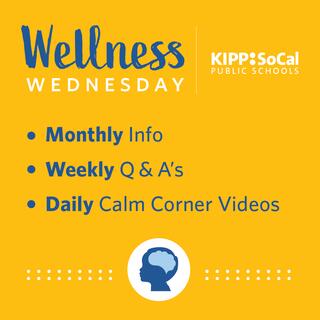
#WellnessWednesday
Are you experiencing difficulties in creating a learning environment that’s engaging and motivating for your children? We must consider how children can become overwhelmed with changes, including concerns about COVID-19, new routines, and the well-being of family members and how that may impact their learning.1 So let’s dive into basic strategies to help support children’s mental and emotional health during distance learning.
First, all behavior is a form of communication. In other words, everything you do, everything our KIPPsters do happens for a reason and communicates something during every moment of every day. A student’s behavior can communicate an underlying need, or function, and can inform us on what they want or don’t want in a situation. To specify, our School Psychology Program Manager, Yadira Cervantes, PsyD, PPSC, said “behaviors can communicate through the ‘Four Functions of Behavior’ taken from the theory of Applied Behavior Analysis:
- Escape/ Avoidance: The student behaves in order to get out of or avoid doing something he/she/they does not want to do.
- Attention Seeking: The student behaves to get focused attention from parents, teachers, siblings, peers, and/or other people that are around them.
- Access to Materials/Tangibles: The student behaves in a certain way to get a preferred item or participate in an enjoyable activity.
- Sensory/Automatic Stimulation: The student behaves in a specific way because it feels good to them.
Keep in mind that every child is unique with different experiences. Understanding the function of, or the reasons behind, a student’s behavior is crucial for identifying the proper response and/or support. This can allow the adult to be proactive in finding ways to prevent behavior issues in the future.2
If applicable, try a first/then board, which is a simple visual used to communicate a sequence of tasks.3 Cervantes explained, “prior to the start of any activity, parents/guardians should take control of the reinforcer. Allow students to choose 2-3 preferred activities/reinforcers that are not triggering, overstimulating, distracting, or inappropriate.” You can draw a picture and/or write a word that represents the “first” and “then” activity. This first/then board can be helpful in motivating your child in completing a less preferred task, which would be followed by their desirable activity.
To add, check out the 7 helpful tips for managing children’s behavior during distance learning that our Mental Health and Support Services team has provided:
- Learn About Priming
- Create Clear and Concise Instructions
- Establish Routines and Expectations
- Practice Check-in/Check-out
- Encourage Breaks & Physical Activity
- Use Reinforcement
- Give Yourself Grace
These tips can also help our KIPPsters transition from distance learning to hybrid learning! For instance, “with priming we can give students a heads up and practice new norms such as mask-wearing and sanitation,” said Cervantes. “Parents/guardians can also create structure by setting clear expectations and following their school’s welcome back procedures.” The intention is to help continue creating a healthy, productive, and safe learning environment that is manageable for the student and the parent/guardian.4
It’s important to recognize that parents/guardians can also become overwhelmed with everything they have going on. Having said that, utilizing coping skills is a great way to help stay resilient, which can include practicing self-care techniques, meditation, reflection, music therapy, or even taking a break and calling a friend. Cervantes noted that “being aware of your personal triggers and signals as parents/guardians will allow you to develop patience.”
“By staying in tune with your child’s social and educational welfare, you can be the first to raise any red flags in order to make sure that all of your child’s needs are met,” she added.
Overall, student behaviors can look different from one child to the next and “a parents/guardians’ active engagement is an instrumental part of a child’s educational and emotional growth,” said Cervantes. To stress, in every (virtual) classroom, students’ behavior is an important form of communication. When adults understand what children are trying to communicate through their behavior, they can respond better. KIPP SoCal is Community — Cervantes mentioned, “a team approach will strengthen school-to-home culture and community, as students will understand that their support network is on the same page and will have open lines of communication from school to home.”
 Join us on Wednesday, March 24 at 4 p.m. on Facebook @kippsocal with KIPP SoCal Director of Mental Health & Support Services, Jasmine Lamitte, Geraldine Billiran, Behavior Specialist, MA, EdS, PPSC, Kyndl Charles, Behavior Specialist, MA, and Dr. Yadira Cervantes, School Psychology Program Manager, PsyD, for KIPP SoCal’s March #WellnessWednesday — a bilingual community information session — where you’ll learn more about these strategies to help support children within the distance learning setting.
Join us on Wednesday, March 24 at 4 p.m. on Facebook @kippsocal with KIPP SoCal Director of Mental Health & Support Services, Jasmine Lamitte, Geraldine Billiran, Behavior Specialist, MA, EdS, PPSC, Kyndl Charles, Behavior Specialist, MA, and Dr. Yadira Cervantes, School Psychology Program Manager, PsyD, for KIPP SoCal’s March #WellnessWednesday — a bilingual community information session — where you’ll learn more about these strategies to help support children within the distance learning setting.
1 Behavior Supports During Remote Learning. Retrieved from www.schools.nyc.gov.
2 Understanding Behavior as Communication: A Teacher’s Guide. Retrieved from understood.org.
3 Behavior Supports During Remote Learning. Retrieved from www.schools.nyc.gov.
4 Behavior Supports During Remote Learning. Retrieved from www.schools.nyc.gov.
